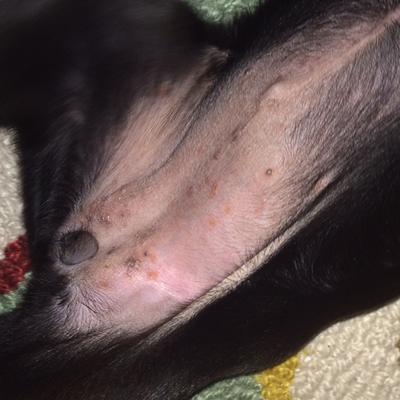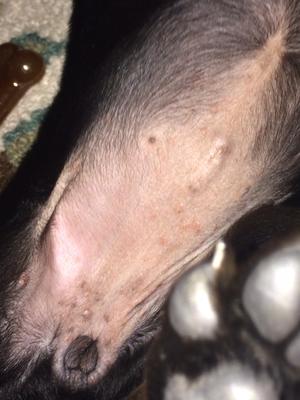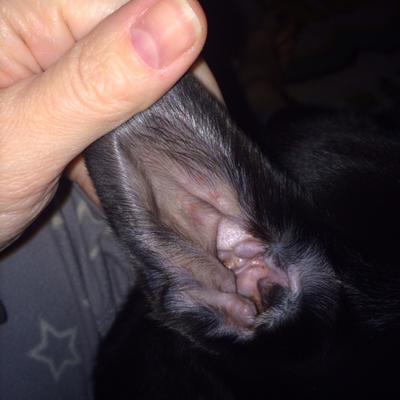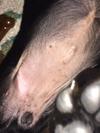by Jessica
(SW Florida)

belly
We rescued a puppy two weeks ago from a humane society. She is approximately 8-10 weeks old. Suspected to be a lab/rottie mix, but seems small, she was very underweight when we brought her home (ribs and hip bones sticking out).
She and her litter mates were found in a storm drain when they were very young (2-3 weeks) without their mother, so she was separated from her mother very early. The shelter supposedly fed her Science Diet Puppy, of which they sent us home with a small bag. I do not like Science Diet, so I switched her over to Fromm’s Large Breed Puppy kibble over the course of her two weeks with us.
When we brought her home she still had hookworms, despite being treated at the shelter, so our vet had us give her a 3-day course of dewormer last week. Now, because she’s a shelter pup, the shelter gave her multiple vaccines before they’d let her leave. But when I took her to our vet, the vet said that was unusual for such a young puppy. I am supposed to take her back this week for boosters and another fecal though.
She has put on weight nicely and looks healthier now. She’s very alert and active and loves to play with our other small breed dog and child. So she’s not lethargic and her stools are firm. She’s picking up potty training quickly and is taking to small doses of crate training well.
We do not treat our yard with any pesticides, but every once in awhile the lawn maintenance crew will treat for weeds along the perimeters. Since she is a puppy, and we are potty training, she’s been outside a lot (we live in Southwest Florida). We have White Oleander trees at the back of the yard as well as Milkweed in a butterfly garden. I know both of those can be toxic. I’ve tried my hardest to keep her away from them, but again, she’s a puppy. She wants to put everything in her mouth.
Neither dog has evidence of fleas. And though the temperature is mild here in FL we won’t have a “flea boom” until summer.
Because she was freshly spayed when we brought her home, I’ve been monitoring her wound closure daily to make sure everything is okay. Only today I noticed a red rash on her belly and legs.
I tried to inspect the rest of her but her hair is dark and extremely short. I could not see any red spots under her fur on her rump, back or front legs (yet…it may spread). So I thought contact allergy.
But then I noticed red spots inside her ears… which I thought was weird for a contact allergy. So, I’m stumped.
On the one hand I have no idea what she brought with her from the shelter. On the other, I have no idea if she could have a food allergy, a vaccine problem, a medicine reaction, a reaction to something in the yard… Or if she’s having a problem with something in the house.
Because I have another small dog and young child, I use only non-toxic products in my house. And my child is extremely sensitive to detergents/soaps so I use only free and clear (organic when possible) laundry detergents, soaps, lotions, etc. I found an enzymatic stain and odor remover that claims to be safe for kids and pets to clean up her accidents.
The puppy doesn’t seem to be chewing or licking any more than she has since the rash developed in the last 12 hours.
I know puppies have sensitive skin to begin with, what could be going on and how do I figure it out?
Are there natural remedies as opposed to prescribed medicines for stuff like this?
My 8 year old dog has never had a skin problem, so this is a first. It’s Sunday and I’m not scheduled to take her to the vet until Thursday. Just hoping to get some advice in the meantime to hopefully alleviate the problem or her probable discomfort.
Or if it’s something you think is contagious to our other dog or to us, I’d take her in to the vet immediately.
Thank you in advance for your help.
Comments for Red Puppy Rash on Underside & Ears | ||
| ||
Click here to go back to the Ask a Vet Online Library of questions.
Do you believe in holistic pet care? If so, please tell your friends about us. Thank you for supporting our efforts!
Also see…
- Back to Dog Health Problems Symptoms / Dog Illness Signs Symptoms / Natural Dog Remedies
- Back to 10 Best Dog Food Options / Dog Food Ratings / Buy Dog Food Online
- Back to Conventional vs. Holistic Veterinarians
- Back to Organic Dog Supplies Online
- Back to Pet Friendly Airlines / Pet Friendly Travel
- Back to Organic Pet Digest Natural Dog Care Home Page






